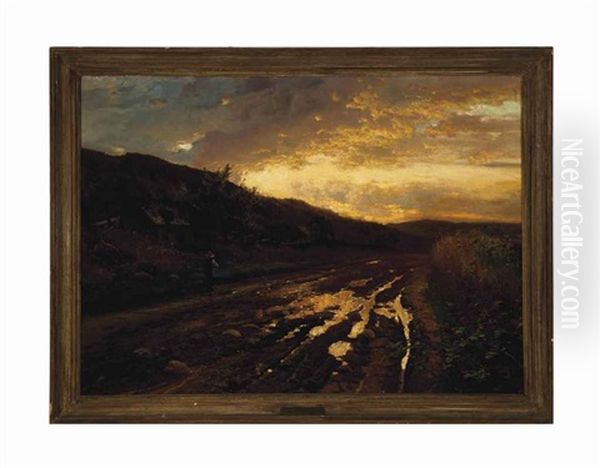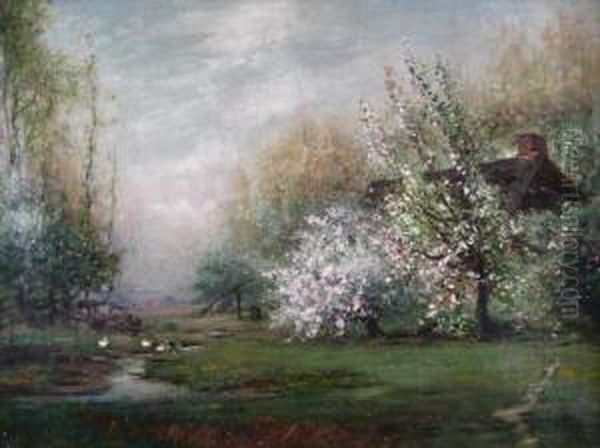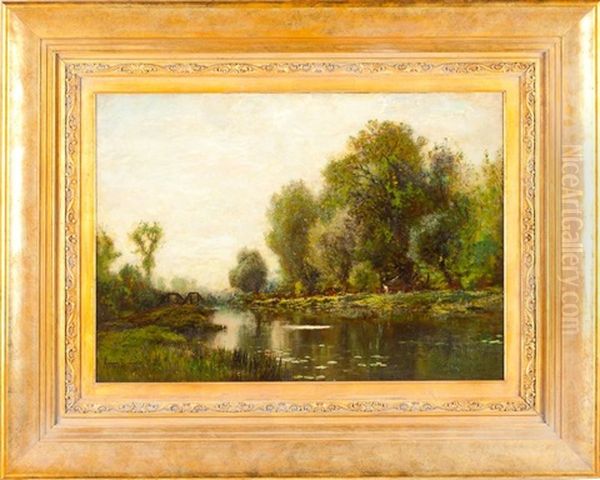Arthur Parton (1842-1914) stands as a significant figure in the landscape of American art during the latter half of the 19th and the early 20th centuries. Born in Hudson, New York, a location intrinsically linked to the art movement that would initially shape his career, Parton became a respected landscape painter known for his evocative depictions of the American wilderness and pastoral scenes. His artistic journey reflects the broader transitions occurring in American art during his lifetime, moving from the detailed naturalism of the Hudson River School towards the more atmospheric and subjective approaches influenced by European trends, particularly the Barbizon School.
Early Life and Artistic Formation
Born in 1842 in Hudson, New York, Arthur Parton grew up surrounded by the very landscapes that had inspired the first generation of Hudson River School painters like Thomas Cole and Asher B. Durand. This environment likely played a role in fostering his early interest in art and nature. His formal artistic training began not in New York, but in Philadelphia, where he studied at the prestigious Pennsylvania Academy of the Fine Arts (PAFA).
At PAFA, Parton had the distinct advantage of studying under William Trost Richards. Richards, himself a notable painter associated with both the Hudson River School and the American Pre-Raphaelite movement, was known for his meticulous attention to detail and geological accuracy, as well as his later, more atmospheric marine paintings. This tutelage undoubtedly grounded Parton in the techniques of careful observation and naturalistic representation that characterized the Hudson River School aesthetic. Parton first began exhibiting his works in Philadelphia, marking the start of a long and productive career.
Establishing a Career in New York

In 1865, Arthur Parton made the pivotal move to New York City, the undisputed center of the American art world at the time. This relocation placed him amidst a vibrant community of artists and provided access to crucial institutions and exhibition venues. He quickly became associated with the National Academy of Design (NAD), a cornerstone institution for American artists. Beginning in 1864, even before his permanent move, Parton started exhibiting his works regularly at the NAD's annual exhibitions, a practice he would continue for much of his career. His consistent presence at the NAD solidified his reputation and integrated him into the city's artistic fabric. He was elected an Associate of the NAD in 1871 and achieved the status of full Academician in 1884.
A significant aspect of Parton's New York life was his association with the Tenth Street Studio Building. In 1874, he and his wife moved into this famous structure, which served as a vital hub for many prominent artists of the era, including luminaries like Frederic Edwin Church, Albert Bierstadt, and Sanford Robinson Gifford. Parton maintained his studio there until 1893, placing him physically and professionally at the heart of the New York art scene. Earlier, in 1865, he had briefly shared a studio space on Broadway with his brother, Ernest Parton, who also pursued a career as a landscape painter, initially in America before finding success abroad, particularly in England and France.
European Influence: The Barbizon Connection
Like many American artists of his generation, Arthur Parton sought further inspiration and refinement by traveling to Europe. His visit in 1869 proved particularly transformative for his artistic style. Exposure to contemporary European art, especially the works of the French Barbizon School painters, left a lasting impression. Artists like Jean-Baptiste-Camille Corot, Jean-François Millet, Théodore Rousseau, and Charles-François Daubigny championed a different approach to landscape painting than the highly detailed, often panoramic views favored by the Hudson River School.
The Barbizon painters emphasized painting outdoors (en plein air), capturing the mood and atmosphere of the landscape, often focusing on simpler, more intimate rural scenes. They employed looser, more visible brushwork and a palette that often favored tonal harmonies over brilliant, descriptive color. Parton absorbed these influences, and upon his return, his style began to evolve. While not abandoning the naturalism learned from Richards, his brushwork became softer, his compositions often more pastoral, and his interest in capturing specific light effects and atmospheric conditions—hallmarks of Tonalism—grew more pronounced.
A Synthesis of Styles: Parton's Mature Vision

Arthur Parton's mature style represents a fascinating synthesis of his American training and European influences. He never fully relinquished the Hudson River School's dedication to depicting recognizable American locations, but he rendered these scenes with the softer touch and evocative moodiness inspired by the Barbizon aesthetic. His landscapes often possess a quiet, poetic quality, emphasizing the interplay of light and shadow and the subtle gradations of color found in nature, particularly during twilight or under overcast skies.
This blending of approaches placed Parton among a group of American artists navigating the transition away from the dominant Hudson River School style. His work shares affinities with American Tonalism, a movement characterized by its emphasis on atmosphere, mood, and harmonious color schemes, often in muted tones. Key figures in Tonalism include George Inness and Alexander Helwig Wyant, whose works, like Parton's later paintings, prioritize emotional resonance and suggestion over precise topographical detail. While perhaps not strictly an Impressionist, elements associated with Impressionism, such as a concern for capturing fleeting light effects, can also be discerned in some of his works, reflecting the diverse artistic currents of the late 19th century. His style also occasionally touched upon Luminism, particularly in his handling of light and atmosphere.
Chronicler of the American Landscape
Throughout his career, Parton remained dedicated to capturing the beauty of the American landscape. He frequently painted the wilderness areas favored by the Hudson River School, including the Adirondack Mountains and the Catskill Mountains of New York State. These regions offered dramatic scenery—lakes, forests, and mountains—that he interpreted through his evolving stylistic lens. He often returned to the gentler, more pastoral landscapes of the Hudson River Valley as well.
Parton also gained particular acclaim for his depictions of the Shenandoah Valley in Virginia. His ability to capture the unique character and atmosphere of these different regions was a hallmark of his work. Whether painting the rugged peaks of the Adirondacks or the serene flow of the Shenandoah River, Parton sought to convey not just the physical appearance of the landscape but also its inherent mood and spirit. His paintings serve as both records of specific places and evocative interpretations of nature's varied aspects.
Major Works and Public Acclaim
Several specific works highlight Arthur Parton's artistic achievements and contributed to his reputation. His painting titled Shenandoah River garnered significant attention, particularly after it was engraved and featured in William Cullen Bryant's popular publication Picturesque America (issued in parts 1872-1874). This widely circulated book brought images of the American landscape to a broad audience, and the inclusion of Parton's work significantly boosted his visibility and renown.

Another key painting, November, Loch Lomond and Solitude, achieved national recognition when it was exhibited at the Philadelphia Centennial Exposition in 1876. This major international fair was a showcase for American arts and industry, and success there was a mark of considerable distinction. Parton's evocative Scottish scene (though he primarily painted American landscapes, he did travel and paint abroad) demonstrated his skill in capturing atmospheric effects and resonated with the public and critics alike. He also worked proficiently in watercolor, as evidenced by works like Niagara Falls, showcasing his versatility across different media.
Awards and Recognition
Parton's contributions to American art were recognized through numerous awards and honors throughout his career. In 1886, he received a prestigious Gold Medal from the American Art Association in New York for his painting Evening After the Rain. His alma mater, the Pennsylvania Academy of the Fine Arts, awarded him the Temple Medal for In the Month of May.
His work also received international accolades. He was awarded an Honorable Mention at the Paris Exposition Universelle in 1900, a testament to his standing beyond American shores. Furthermore, he received an award at the Louisiana Purchase Exposition held in St. Louis in 1904. These honors, bestowed by major national and international bodies, affirmed his status as a leading landscape painter of his time and reflected the high regard in which his work was held by juries and the public.
Professional Life and Affiliations
Beyond his painting and exhibitions, Arthur Parton was an active member of the New York art community through his participation in several important organizations. His long and deep involvement with the National Academy of Design, culminating in his election as a full Academician, was central to his professional life.
He was also a member of the American Watercolor Society (AWS), reflecting his skill and interest in that medium. He exhibited regularly with the AWS from 1880 onwards. Additionally, Parton belonged to the Artists' Fund Society, an organization dedicated to providing financial assistance to artists in need. These affiliations demonstrate his commitment to the professional structures of the art world and his engagement with fellow artists.
Parton in Context: Contemporaries and Influence
Understanding Arthur Parton's place in American art history requires situating him among his contemporaries. His initial influence came from his teacher, William Trost Richards, and the broader Hudson River School tradition established by figures like Thomas Cole and Asher B. Durand. During his early career, he worked alongside prominent second-generation Hudson River School painters such as Frederic Edwin Church, Albert Bierstadt, Sanford Robinson Gifford, Jasper Francis Cropsey, and John Frederick Kensett, though his style would eventually diverge from their often grander, more detailed canvases.
His brother, Ernest Parton, provides a point of comparison, as both brothers pursued landscape painting, though Ernest spent much of his career in Europe. Parton's stylistic shift connects him to the Barbizon painters like Corot and Daubigny, and more directly to the American artists who embraced similar ideals, such as the Tonalists George Inness, Alexander Helwig Wyant, and Dwight William Tryon. As American Impressionism gained prominence later in Parton's career, led by artists like John Henry Twachtman, J. Alden Weir, and Childe Hassam, Parton's work, while not fully Impressionist, occupied a space influenced by similar concerns for light and atmosphere, positioning him as a transitional figure bridging mid-century realism and late-century atmospheric painting.
Legacy and Collections
Arthur Parton died in New York City in 1914, leaving behind a substantial body of work that chronicles the American landscape through a period of significant artistic change. His legacy lies in his ability to adapt and synthesize different artistic influences, creating landscapes that were both grounded in observation and imbued with personal feeling and atmospheric effect. He successfully navigated the shift from the detailed realism of the Hudson River School towards the more subjective and moody styles that emerged in the late 19th century.
His contributions were recognized during his lifetime and continue to be acknowledged today. His paintings are held in the permanent collections of numerous important American museums, including the Metropolitan Museum of Art in New York, the Brooklyn Museum, the Pennsylvania Academy of the Fine Arts, the Boston Museum of Fine Arts, the Indianapolis Museum of Art, and the Jersey City Museum, among others. The presence of his work in these institutions ensures its accessibility to future generations and confirms his enduring place in the story of American art.
Conclusion
Arthur Parton was a dedicated and accomplished American landscape painter whose career spanned a dynamic era in art history. From his origins in the Hudson River Valley and his training under William Trost Richards, he developed a style initially rooted in the detailed naturalism of the Hudson River School. His exposure to European art, particularly the Barbizon School, led to a significant evolution, incorporating softer brushwork, a greater emphasis on mood and atmosphere, and a Tonalist sensibility. He remained a keen observer of the American scene, capturing the distinct character of the Adirondacks, Catskills, and Shenandoah Valley. Through his prolific output, numerous exhibitions, prestigious awards, and presence in major museum collections, Arthur Parton secured his legacy as an important transitional figure who skillfully blended American landscape traditions with emerging international styles, leaving behind a rich visual record of the natural world as seen through the artistic lens of the late 19th and early 20th centuries.